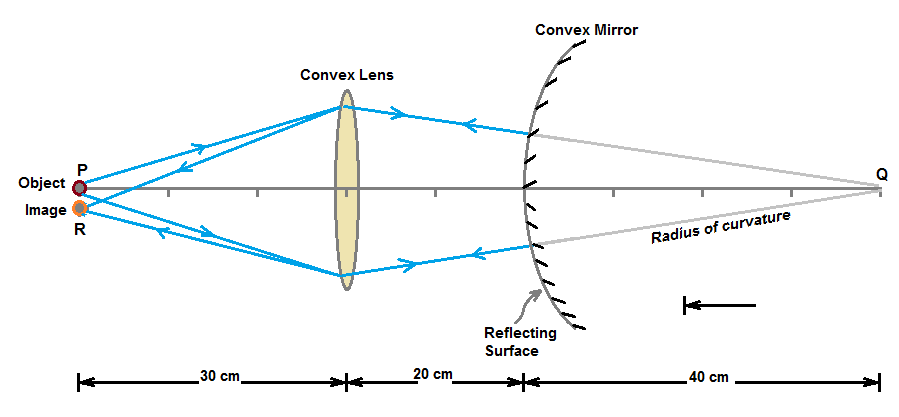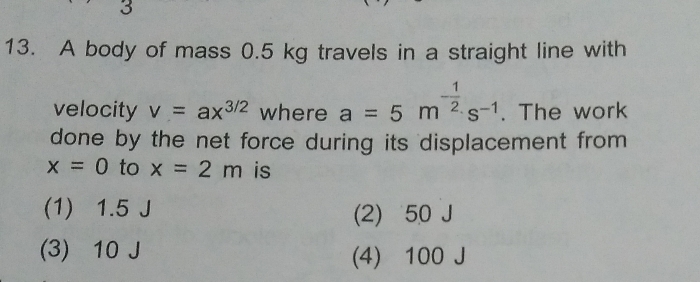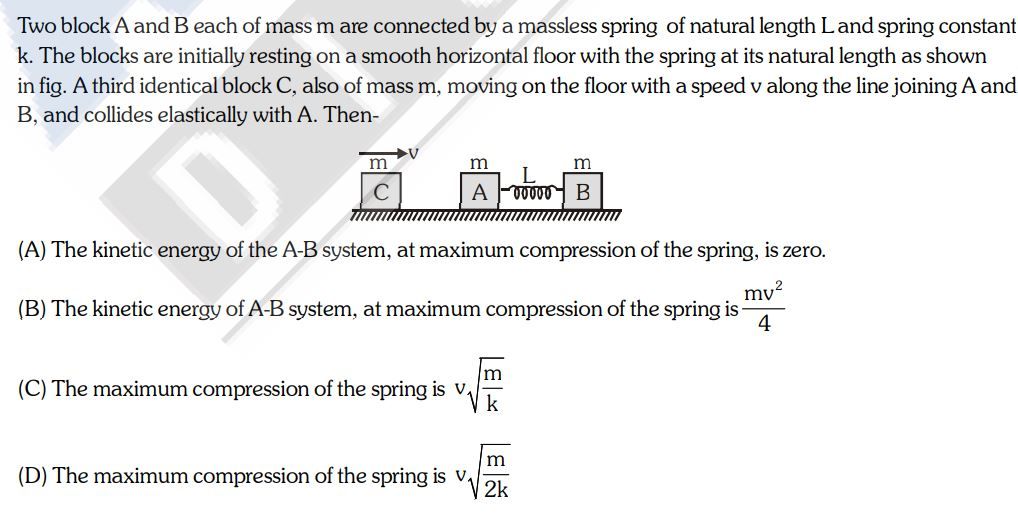JEE Class main Answered
solve question

Asked by rasjad355 | 15 Jan, 2023, 04:49: PM
Question (42)
Initial speed of block when it is placed on conveyor will be 4 m/s
Initial kinetic energy = (1/2) m v2 = 0.5 × 0.5 × 4 × 4 = 4 J
Workdone to stop the block equals initial kineteic energy
Workdone to stop the block = 4 J
-----------------------------------------------------------
Question (43)
!6 gm of helium = 16/4 = 4 moles
Constant volume specific heat of helium (mono-atomic) = (3/2)R J/( mole K )
Constant pressure specific heat of helium (mono-atomic) = (5/2)R J/( mole K )
28 gm of nitrogen = 28/28 = 1 moles
Constant volume molar specific heat of nitrogen (di-atomic) = (5/2)R J/( mole K )
Constant pressure molar specific heat of nitrogen (di-atomic) = (7/2)R J/( mole K )
mole fraction of helium = 4/5 ; mole fraction of nitrogen = 1/5 ;
Constant volume molar specific heat of mixture = [ (4/5) (3/2) R ] + [ (1/5) (5/2) R ] = (17/10)R
Constant pressure molar specific heat of mixture = [ (4/5) (5/2) R ] + [ (1/5) (7/2) R ] = (27/10)R
Ratio of constant volume molar specific heat to constant pressure molar specific heat is (17/27)
---------------------------------------------------------------------------------------
question (44)
To get maximum current through zenar diode , let us consider maximum voltage 80V of power supply.
Potential difference across 5 kΩ resistance is ( 80 -30 ) V = 50 V
Current Is through 5 kΩ is = 50 V / 5 kΩ = 10 mA .
Since potential difference across zenar diode is 30V ,
current through 20kΩ load resistance is ( 30V / 20kΩ ) = 1.5 mA
Current through zenar diode = ( 10 -1.5) mA = 8.5 mA
--------------------------------------------------------------------------------------------------------------
Question (45)

Point object is at P at a distance u = - 30 cm from convex lens of focal length f = 20 cm .
(Cartesian sign convention is followed )
image distance v from lens without convex mirror is calculated using lens equation


we get v = 60 cm from above expression.
Now if we place convex mirror at a distance 20 cm from convex lens as shown in figure and
if we get image at R that is side by side of object point P , then light rays are retraced in same path
of incidence after reflection by convex mirror.
If the convex mirror retrace the light rays in same path of incidence after reflection ,
then light rays incident on convex mirror at normal direction.
Hence if we extend the point of incidence towards first image point Q , Then Q is centre of curvature.
Hence radius of curvature of convex mirror = ( 60 - 20 ) cm = 40 cm
Answered by Thiyagarajan K | 15 Jan, 2023, 08:42: PM
JEE main - Physics
Asked by sarthakbhoskar7630 | 05 Mar, 2024, 07:03: PM
JEE main - Physics
Asked by fekishfaker | 18 Nov, 2023, 01:39: PM
JEE main - Physics
Asked by theavengers0203 | 24 May, 2023, 08:40: AM
JEE main - Physics
Asked by mdowaisraza581 | 16 May, 2023, 10:06: PM
JEE main - Physics
Asked by swayamagarwal2114 | 21 Jul, 2022, 05:17: PM
JEE main - Physics
Asked by vishal.vini86 | 22 Apr, 2022, 12:06: AM
JEE main - Physics
Asked by pratham.k | 02 Jun, 2020, 12:20: AM
JEE main - Physics
Asked by Vedantshinde4may | 25 Feb, 2019, 05:10: PM





